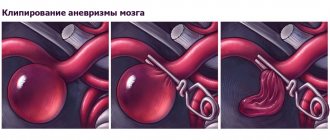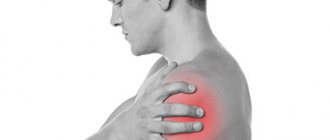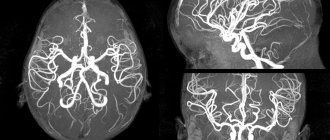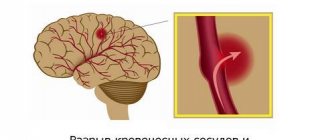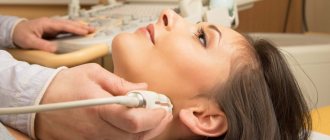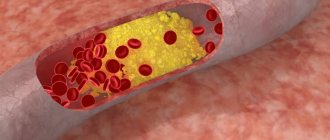Symptoms of cerebral atherosclerosis
Unfortunately, cerebral atherosclerosis may not manifest itself for years. Only regular examination and monitoring of blood sugar and lipid levels helps to recognize the impending danger in time and take effective measures.
Entrust your health to the professionals of the multifunctional center of the FMBA of Russia with extensive experience in the treatment of patients with vascular pathology, as well as prevention and subsequent recovery. Annual monitoring of your health will help you prevent vascular accidents in time and maintain a high quality of life for many years.
Below is Table 1 with the most common symptoms of cerebral atherosclerosis at different stages of the disease. It will help you recognize the first signs of pathology and promptly seek medical help.
| Stage | Patient complaints |
| First stage | Often : headache, tinnitus, memory loss (remembers the past well, but cannot remember new information. Often : asthenia - fatigue, weakness, inattention, general lethargy. Relief may occur after rest. Rarely : sleep disturbance, insomnia or daytime sleepiness. |
| Second stage | Disease progression . Anxiety, suspiciousness, mood swings, and a tendency toward depression appear. Memory loss: a person does not remember what happened today and stops thinking clearly and logically. Headache and tinnitus become constant. Speech: unclear, diction changes. Tremors of the limbs and head appear. Vision and hearing deteriorate. Coordination in space deteriorates: dizziness and unsteadiness of gait are bothersome. There may be a loss of sensitivity in one half of the body and the appearance of facial asymmetry. |
| Third stage (irreversible) | Dementia develops . The patient may behave like a child or become whiny and aggressive. Not interested in the world around him and the events in it. Not oriented in space and time. There is complete or partial memory loss. Needs constant care because he has lost self-care skills at home. |
Such complaints may indicate that the lumen of an important vessel in the brain is closed by more than 50%. Be attentive to your health!
Self-medication of cerebral atherosclerosis is not acceptable!
Even at the first stage! As we said above, the first symptoms of the disease appear already with a significant degree of vascular damage.
Entrust your health to specialists with many years of experience in the treatment of vascular accidents and subsequent neurorehabilitation. Start by seeing a neurologist and tell him about how you have been feeling over the past months.
A professional, sensitive attitude towards patients and attention to detail will allow us to recognize and prevent irreversible changes in the brain in time.
Treatment methods
Medication
This method is prescribed if the disease is at an early stage of development.
Typically, the patient is prescribed a whole list of medications, which includes the following types of medications:
- antioxidants;
- means aimed at narrowing blood vessels;
- satins - drugs intended to reduce cholesterol levels in the body;
- fibrates - agents that prevent lipids from concentrating in the blood;
- antidepressants;
- tranquilizers.
What is vasoconstriction and how to deal with this pathology is described in the video:
Surgical
This method is used if the vessels have narrowed by more than 60%.
The following surgical options are used to treat the disease:
- carotid endarterectomy;
- angioplasty;
- stenting.
The first option is scraping plaques from the walls of blood vessels. The second is the dilation of blood vessels, which occurs due to the installation of a special catheter. The third method is to fix a special wire frame that straightens the narrowed area.
From the editor: Features of people with schizophrenia
Massage
This method can be considered as restorative and preventive against new diseases. Only a professional who takes into account physiological characteristics can give a massage.
He will need to provide pictures of the spine so that the specialist knows which areas need to be worked on. Typically a massage consists of stroking, rubbing and kneading movements.
This method helps relieve spasms, improve blood flow into the vessels, as well as cells and tissues of the body.
ethnoscience
In folk medicine, there is a wide variety of recipes that will help reduce the manifestation and sometimes completely eliminate vasoconstriction. However, this is only possible if the patient adheres to proper nutrition.
Hawthorn tincture:
- Pour 2 tablespoons of hawthorn fruit into 0.2 boiling water.
- Infuse the composition for half an hour.
- Afterwards, the infusion needs to be cooled and strained.
- You need to add water so that you get 1000 ml of water.
- Next, add 1 kg of sugar and one chopped lemon.
- After this, boil the mixture for 5 minutes.
- Take 1 tablespoon once a day.
A mixture of garlic and lemon.
Grind 0.5 kg, place in a one and a half liter jar and fill completely with water. Leave for 10 days to infuse. Stir the contents every day. After this, add 0.5 kg of lemon to the garlic. Mix everything thoroughly.
Take one tablespoon daily after meals.
Physiotherapy
When treating vasoconstriction of the cervical spine, an important fact is the use of physiotherapy, which includes the use of:
- pulsed magnetic fields;
- acoustic shock waves;
- mineral showers and baths;
- magnetic therapy;
- dosed exposure to electric current;
- detensor therapy;
- low-intensity laser radiation;
- ultrasound therapy.
Nutritional Features
Patients with this diagnosis need to limit their intake of foods that contain large amounts of cholesterol and fatty foods. Include more fruits and vegetables in your diet.
Animal fats, butter and even margarine are of particular benefit to patients. There should be a lot of meat.
Also, do not forget about dairy and fermented milk products, preferably low in fat. The body needs porridge and spices.
It is better to avoid pasta and coffee drinks. Herbal teas (both green and black) are of great benefit.
Diagnostics
A neurologist deals with cerebral atherosclerosis. His task is to collect anamnesis, as well as conduct a series of tests. Doctor:
- will ask you to look up (a sick person will not be able to fulfill the request);
- will check the reflexes (they will be either excessively high or low, and asymmetrically);
- will ask you to stretch your arms forward and look to see if there is any tremors in the fingers, or if the patient is losing balance;
- will ask you to touch your nose with the tip of your finger with your eyes closed (the patient will not be able to cope with this task).
This is only a small component for assessing the patient’s health. Therefore, more detailed examinations are required next:
- consultation with an ENT doctor, ophthalmologist and other specialists depending on the identified disorders;
- biochemical blood test for triglycerides and cholesterol (lipid spectrum);
- According to indications, instrumental examinations are carried out.
To assess the condition of cerebral vessels, the following is carried out:
- Ultrasound of the brain and neck using two-dimensional and transcranial duplex scanning technology;
- angiography of cerebral vessels;
- Doppler ultrasound;
- MRI of the brain in vascular mode;
- REG (radioencephalogram);
- CT computed tomography of the brain and blood vessels;
- EEG – electroencephalogram.
The diagnostic capabilities of our multifunctional center of the FMBA of Russia allow us to carry out not only these, but also any other examinations necessary for the patient using the most modern and accurate equipment. You will be able to get advice from related specialists on any clinical case, including suspected cerebral atherosclerosis.
Treatment of cerebral atherosclerosis
It is not only the neurologist who treats patients with atherosclerosis in our center. We treat the disease comprehensively with the involvement of doctors from different specialties. This approach makes the recovery process comfortable, gives better results and helps patients return to their normal lives sooner.
The basis for the treatment of cerebral atherosclerosis is the correct selection of nutrition. On the one hand, the diet combines a complete diet with individually designed physical activity. On the other hand, medications help compensate for the pathological process and reduce the harmful effects of the disease on the body.
Medicines used:
- diuretics;
- drugs that normalize lipid and blood sugar levels;
- vitamins;
- drugs to improve cerebral circulation;
- means for normalizing blood pressure and heart rate;
- thrombolytic agents, etc.
Prevention
Below are a few useful habits that will help significantly reduce the risk of developing atherosclerosis:
- to give up smoking;
- nutrition balanced in composition of nutrients;
- correction and maintenance of optimal body weight;
- annual preventive monitoring of lipid and blood sugar levels.
The diagnostic capabilities of our center allow us to establish a diagnosis quickly and accurately. Based on the results of the examination, you will be advised by experienced neurologists, whose knowledge has helped save hundreds of patients.
Also, individual health monitoring programs have been developed on the basis of the Federal Scientific and Clinical Center of the Federal Medical and Biological Agency of Russia.
- for men (under 40 years old, over 40 years old, standard);
- for women (under 40 years old, over 40 years old, standard based on age and optimal)
Don't put off taking care of your health. Call us or make an appointment to assess your risk of atherosclerosis and receive comprehensive recommendations.
Symptoms of various vascular diseases of the head and neck
There are many known diseases of blood vessels in medical practice. Each of them has its own clinical picture. But the final diagnosis is made only by a specialist based on the results of the examination. Signs common to all diseases:
- sudden attacks of dizziness, which are accompanied by loss of coordination and fainting;
- pain that is localized in the back of the head is the main symptom of stenosis;
- state of lethargy, fatigue or, on the contrary, increased irritability;
- limited physical activity;
- problems with memory, concentration, signs of dementia;
- feeling of heaviness in the head.
Important!
Cause for concern - these signs are observed regularly.
Atherosclerosis
The most common cause of violations. The disease develops against the background of the formation of atheromatous plaques on the inner surface of the arteries. If left untreated, the connective tissue gradually grows, making it difficult to fully supply the brain with blood. Signs of atherosclerosis are most often observed in people over 50-60 years of age.
From the editor: In what cases can an MRI be done?
The condition occurs against the background of regular intake of fatty foods, physical inactivity, and metabolic disorders. Bad habits are also important - smoking, drinking alcohol.
Spasms
The condition is accompanied by a narrowing of the lumen between the walls of capillaries and blood vessels. This can be observed against the background of vasospasm - intense reflex muscle contraction. The reason for this may be the following conditions:
- vegetative-vascular dystonia;
- disturbances in the functioning of the heart;
- kidney and thyroid dysfunction.
Provoking factors also include regular hypothermia, overwork, and lack of sleep. Among the congenital pathologies that can cause stenosis are:
- underdevelopment of neck vessels;
- bone formations on the vertebrae.
Hypertension
The main characteristic is high blood pressure. The stenosis that occurs against this background leads to the fact that the vessels lose their elastic qualities. Pathology can cause spasms, paralysis, decreased or even loss of sensation in the limbs.
Advice!
The clinical picture is observed extremely rarely. Therefore, hypertensive patients should regularly measure their blood pressure. If three times the results may exceed 140 mmHg. Art., you should consult a doctor.
Cervical hernia
The condition is accompanied by rupture of the fibrous ring of the intervertebral disc and release of the nucleus. The clinical picture is formed by the following phenomena:
- pain in the upper spine, which intensifies due to changes in head position;
- numbness, tingling in the hands;
- muscle weakness;
- headaches, coordination problems.
The symptoms of a hernia are the most striking. Therefore, detection of pathology occurs in the early stages. Especially when compared with other vascular diseases.
Osteochondrosis
Dystrophic changes in intervertebral discs in the cervical region. The damage also extends to the vertebrae, soft and cartilaginous tissues. It can lead to the development of a hernia, which in medicine is called intervertebral protrusion.
Osteochondrosis is caused by a number of factors. For example, cervical injuries, lack of physical activity. Also, holding the neck in an uncomfortable position for a long time, hereditary predisposition, prolonged mental stress.
